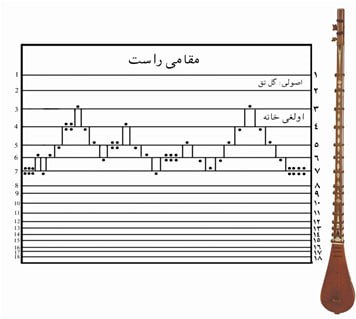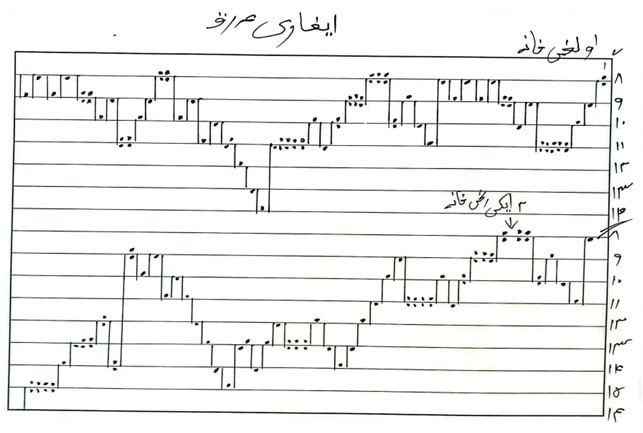One poet, one invention, and the musical history of a nation…
🔴 Have you heard about the immortal code created in Khorezm in the past century?
🔴 Who saved folk music from disappearing?

Today, within the framework of the “Komil Khorezmi” media project at the exhibition of the Center of Islamic Civilization in Uzbekistan, efforts are underway to promote his legacy, create exhibits, models, and multimedia products. This is an important step in bringing the name and creativity of this scholar to the wider public.
Central Asia, particularly Khorezm, has for centuries given the world many great scholars, scientists, and creators. From this land came Abu Rayhan al-Biruni, Mahmud al-Zamakhshari, Alisher Navoi, and Zahiriddin Babur, who all made invaluable contributions to the progress of humanity. In the 19th century, the flourishing of Khorezm’s cultural and spiritual life was closely linked with the name of Muhammad Rahim Khan Feruz.
Feruz paved the way for enlightenment and art in the khanate, gathering many poets and scholars around his court. It was in this intellectual environment that the poet, statesman, and musicologist Muhammadniyoz Komil (Komil Khorezmi) lived and created. His name was eternally inscribed in history thanks to his invention of the Uzbek national musical notation system the “Tanbur Line”.
Life and political activity
Komil Khorezmi was born in Khiva in 1825. His father, Abdulla Akhund, was a madrasa teacher. From a young age, Komil was interested in science and poetry. He studied first at a traditional school and later at the madrasas of Khiva. During his education, he mastered Persian and Arabic, developed a passion for writing poetry, and soon became known as a famous poet.
His literary pen name was “Komil”, and his ghazals and qasidas carried themes of homeland, enlightenment, justice, and humanism. Komil Khorezmi was not only a poet but also a calligrapher and translator who introduced many works to the people.
Politically, Komil Khorezmi was also active, rising to the position of chief secretary in the Khiva Khanate. In 1873, when Russian troops marched on Khiva, he advocated for a policy of peace. Thanks to his diplomatic efforts, the Khiva Khanate was not completely destroyed, and the people were saved from mass slaughter.
Because of this, his activities were noted not only by Russian historians of the time (F. Lobosevich, MacGahan) but also by local chroniclers. While some sources criticized his inclination toward compromise, in reality his actions served to preserve the homeland a historical truth.
 The national musical notation – the “Tanbur Line”
The national musical notation – the “Tanbur Line”
At the end of the 19th century, Muhammad Rahim Khan II (Feruz) put forward the idea of recording folk melodies on paper. This task was entrusted to Komil Khorezmi.
In 1873–1874, Komil Khorezmi created the national musical notation system known as the “Tanbur Line.” Its main features were:
▪️ constructing horizontal lines corresponding to the frets of the tanbur;
▪️ marking each beat and movement with specific dots;
▪️ using different symbols to distinguish between high and low beats;
▪️ dividing maqoms into sections (khonas) to clearly indicate the structure and rhythm of the melody.
Komil Khorezmi was the first to transcribe the “Segoh” maqom using this method. Later, his son Muhammad Rasul Mirzaboshi refined the system and recorded the entire Shashmaqom. In this way, for the first time in history, folk music was fully documented through notation.
Khorezm maqoms and their importance
Khorezm maqoms are regarded as the highest examples of Uzbek musical heritage. They are valued not only as the spiritual expression of the people but also as an integral part of national culture.
The fact that maqoms were transcribed onto paper through Komil Khorezmi’s “Tanbur Line” ensured their preservation from extinction. This achievement was invaluable not only in safeguarding the national musical art but also in passing it on to future generations.
Today, several copies of these notations are preserved in the Institute of Oriental Studies of the Academy of Sciences of Uzbekistan, the National Archive, the Museum of the State Conservatory, and in various private collections.
Komil Khorezmi and the art of calligraphy
Komil Khorezmi was known not only as an enlightened poet but also as a highly skilled calligrapher. Living in the Khiva Khanate in the 19th century, he became famous for his refined art of handwriting. His calligraphic mastery is reflected in numerous manuscripts, particularly in books dedicated to knowledge and enlightenment.
Komil Khorezmi copied many manuscripts, adorning them with beautiful calligraphy. His writings were admired not only for their accuracy but also for their elegance. Moreover, he mastered various styles of script and contributed to their refinement.

The significance of Komil Khorezmi’s legacy
Komil Khorezmi entered history not only as a poet and statesman but also as a great enlightener who preserved the spiritual values of the people. The national musical notation he created gave strong impetus to the development of Uzbek music.
In addition, his poetry, translations, and calligraphy hold an important place in the spiritual life of the people. His works were published and disseminated to the public in the 20th century and included in the curricula of schools and higher educational institutions.
In the personality of Komil Khorezmi, the nation’s high spirituality, patriotic spirit, and pursuit of scientific and creative innovation were embodied. His national musical notation system, known as the “Tanbur Line”, elevated Uzbek musical culture to a new level.
Therefore, the name of Komil Khorezmi will forever remain in the cultural history of not only Khorezm but the entire Uzbek people. His legacy will continue to serve as a source of inspiration and pride for future generations.
Durdona Rasulova
P/S.: The article may be used by citing the official website of the Center.
Most read

Over 100 experts from more than 20 countries of the world are in Tashkent!

President of Serbia Aleksandar Vučić visited the Islamic Civilization Center in Uzbekistan

The Center for Islamic Civilization – a global platform leading towards enlightenment











